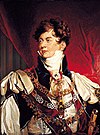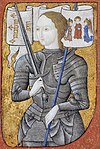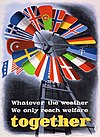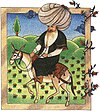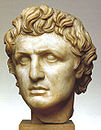Wikipedia:Today's featured article/April 2006
| << | Today's featured articles for April 2006 | >> | ||||
|---|---|---|---|---|---|---|
| Su | Mo | Tu | We | Th | Fr | Sa |
| 1 | ||||||
| 2 | 3 | 4 | 5 | 6 | 7 | 8 |
| 9 | 10 | 11 | 12 | 13 | 14 | 15 |
| 16 | 17 | 18 | 19 | 20 | 21 | 22 |
| 23 | 24 | 25 | 26 | 27 | 28 | 29 |
| 30 | ||||||
April 1
Spoo is a valuable and highly desired food product in the fictional Babylon 5 universe. Originally created by J. Michael Straczynski in 1983, and since its introduction on the Babylon 5 television series, spoo has remained popular among fans of the science fiction saga with references found in areas as diverse as day trading jargon and computer programming. Within the Babylon 5 series, spoo is made from the extraterrestrial worm-like creatures of the same name, and is considered to be the most delicious food in the known galaxy, regardless of which species is asked. Despite its universal appeal as an exceptionally versatile food product, the creature itself is despised, and the cultivation of the herds can be a very depressing occupation. (more...)
Recently featured: Saffron – Yom Kippur War – Voter turnout
April 2
George IV was King of the United Kingdom of Great Britain and Ireland and Hanover from 29 January 1820. He had earlier served as Prince Regent when his father, George III, suffered from a relapse into insanity from porphyria.The Regency (George's nine-year tenure as Regent, which commenced in 1811 and ended with George III's death in 1820) was marked by a victory in the Napoleonic Wars in Europe. George was a stubborn monarch, often interfering in politics (especially in the matter of Catholic Emancipation), though not as much as his father. For most of George's regency and reign, Lord Liverpool controlled the government as Prime Minister. George is often remembered as an extravagant prince and monarch. He had a poor relationship with both his father and his wife, Caroline of Brunswick, even excluding her from his own coronation. He was a patron of the arts; his regency and reign were graced by such literary figures as George Gordon Byron, 6th Baron Byron and Jane Austen. George was responsible for the building of the Royal Pavilion in Brighton. (more...)
Recently featured: Spoo – Saffron – Yom Kippur War
April 3
The New England Patriots are a professional American football team based in Foxborough, Massachusetts. They currently belong to the Eastern Division of the American Football Conference (AFC) in the National Football League (NFL). Originally called the Boston Patriots, the ownership changed location name after relocating the team to Foxborough in 1971. After forming in 1960, the Patriots advanced to the playoffs four times before their first Super Bowl appearance: Super Bowl XX in 1986. The team also lost Super Bowl XXXI in 1997. However, between 2001 and 2005, the Patriots became the second team in NFL history (after the Dallas Cowboys) to win 3 Super Bowls in 4 years (Super Bowl XXXVI, XXXVIII, and XXXIX). Additionally, the Patriots are the seventh team in NFL history to win back to back Super Bowls (XXXVIII and XXXIX respectively). (continued...)
Recently featured: George IV – Spoo – Saffron
April 4
The history of Limerick, the third largest city in the Republic of Ireland and a major cultural and industrial centre, stretches back to its establishment by the Vikings as a walled city on "King's Island" (an island in the River Shannon) in 812, and its charter in 1197. A great castle was built on the orders of King John in 1200. It was besieged three times in the 17th century, resulting in the famous Treaty of Limerick and the flight of the defeated Catholic leaders abroad. Much of the City was built during the following Georgian prosperity, which ended abruptly with the Act of Union in 1800. The depression was to last nearly two centuries, through famine, war, and emergency, until the boom times of the 1990s. The city's position as one of Europe's most westerly points has made it somewhat of a crossroads between the old and new worlds. Famous visitors have included John F. Kennedy, Che Guevara, Boris Yeltsin and Haile Selassie I of Ethiopia. (continued...)
Recently featured: New England Patriots – George IV – Spoo
April 5
Katie Holmes is an American actress best known for her role as the tomboy Joey Potter on The WB television drama Dawson's Creek. The part on the teen soap, only her second professional role, made Holmes a star. Her movie roles have ranged from art films such as Pieces of April to thrillers such as Abandon, but she has not found the same success in films as she did on television, the actress admitting most of her films were "bombs." Holmes began a highly publicized relationship with actor Tom Cruise in 2005; two months after they met they were engaged. Their relationship has made Holmes the subject of international media attention, much of it highly negative, the press speculating the relationship was only a publicity stunt to promote the couple's films. In October 2005, the couple announced Holmes was pregnant. (continued...)
Recently featured: History of Limerick – New England Patriots – George IV
April 6
Lothal was one of the most prominent cities of the ancient Indus Valley Civilization. Located in the state of Gujarat in India, it was discovered in 1954, and its existence dates from 2400 BCE. Lothal's dock—the world's earliest—made the city a vital centre of trade between Harappan cities, West Asia and Africa. The dock, its wharf, lock-gate system, and sophisticated drainage system are unusual marvels of engineering. Lothal yielded the most important Indus-era antiquities in modern India. Its scientists divided the horizon and sky into 8–12 whole parts, pioneering the study of stars and advanced navigation. The techniques and tools pioneered for making beads, gems and in metallurgy have stood the test of time for over 4,000 years. Artisans pioneered realism and modern folktales, and features of Lothal's religion have been linked to Vedic religion—notably joint burials with the custom of sati. (continued...)
Recently featured: Katie Holmes – History of Limerick – New England Patriots
April 7
Thomas Pynchon is an American writer based in New York City. He is noted for his dense and complex fictions. After publishing several short stories in the late 1950s, he began composing the novels for which he is best known today: V. (1963), The Crying of Lot 49 (1966), Gravity's Rainbow (1973), Vineland (1990), and Mason & Dixon (1997). Pynchon is widely acclaimed as among the finest of contemporary authors; he is a MacArthur Fellow and a recipient of the National Book Award, and is regularly cited as a contender for the Nobel Prize in Literature. Both in his fiction and non-fiction his writing encompasses a vast array of subject matter, styles and themes, including (but not limited to) the fields of history, science and mathematics. Pynchon is also known for his avoidance of publicity: very few photographs of him have ever been published, and rumors about his location and identity have circulated since the 1960s. (continued...)
Recently featured: Lothal – Katie Holmes – History of Limerick
April 8
The Kakapo is a species of nocturnal parrot, endemic to New Zealand. It is notable for being the world's only flightless parrot, the heaviest parrot, and the only parrot to have a lek breeding system. It is also the only flightless lek bird and is possibly one of the world's longest-living birds. It is the only species in the genus Strigops and subfamily Strigopinae. Kakapo are critically endangered, with only 86 living individuals known, all of whom are named. Prehistorically, the ancestral Kakapo migrated to the islands of New Zealand and, in the absence of mammalian predators, it lost the ability to fly. With Polynesian and European colonisation and the introduction of predators such as cats, rats, and stoats, almost all the Kakapo were wiped out. Conservation efforts began in the 1890s, but they were not very successful until the implementation of the Kakapo Recovery Plan in the 1980s. All surviving Kakapo are kept on two predator-free islands, Chalky Island in south-west Fiordland and Codfish Island/Whenuahou near Stewart Island/Rakiura, where they are closely monitored. (continued...)
Recently featured: Thomas Pynchon – Lothal – Katie Holmes
April 9
Antarctica is a continent encompassing the southern extremity of Earth, and containing the Earth's South Pole. It is surrounded by the Southern Ocean and divided in two by the Transantarctic Mountains. It is considered to be the coldest, driest, windiest, and highest (on average) continent on Earth, and 98% of Antarctica is covered by ice. There are no permanent human residents and only cold-adapted plants and animals survive there, including penguins, fur seals, lichens, and hundreds of types of algae. The first commonly accepted sighting of the continent occurred in 1820 by the Russian expedition of Mikhail Lazarev and Fabian Gottlieb von Bellingshausen. Antarctica is not under the political sovereignty of any nation, although seven countries (Argentina, Australia, Chile, France, Norway, New Zealand and the United Kingdom) maintain territorial claims. Most other countries do not recognize these claims, and the claims of Argentina, Chile and the United Kingdom all overlap. Human activity on the continent is regulated by the Antarctic Treaty, which was signed in 1959 by 12 countries and prohibits any military activity, supports scientific research, and protects the continent's ecozone. Ongoing experiments are conducted by more than 4000 scientists of many different nationalities and research interests. (continued...)
Recently featured: Kakapo – Thomas Pynchon – Lothal
April 10
OpenBSD is a freely available Unix-like computer operating system descended from Berkeley Software Distribution (BSD), a Unix derivative created by the University of California, Berkeley. It was forked from NetBSD, a previous open source operating system based on BSD, by project leader Theo de Raadt in 1994, and is known among open source enthusiasts for the developers' insistence on open source and documentation, uncompromising position on software licensing, and focus on security and code correctness. OpenBSD includes a number of security features not found or optional in other operating systems and has a tradition of developers auditing the source code for software bugs and security problems, such as W^X and a malloc implementation similar to Electric Fence. The project maintains strict policies on licensing and prefers the open source BSD licence and its variants—in the past this has led to a comprehensive licence audit and moves to remove or replace code under licences found less acceptable. (continued...)
Recently featured: Antarctica – Kakapo – Thomas Pynchon
April 11
Fanny Blankers-Koen was a Dutch athlete. She is most famous for winning four gold medals at the 1948 Summer Olympics in London. At that time, she was already a mother of two, which was unheard of at a time when female athletes were still frowned upon by many. It earned her the nickname "the Flying Housewife." Having started competing in athletics in 1935, she took part in the 1936 Summer Olympics a year later. Although international competition was hampered by World War II, Blankers-Koen set several world records during that period, in events as diverse as the long jump, the high jump, sprint, and hurdling. Apart from her four Olympic titles, she won five European titles and 58 Dutch championships. Blankers-Koen retired from athletics in 1955 after having set or tied 12 world records. After her retirement she became leader of the Dutch female track and field team. In 1999, she was voted "Female Athlete of the Century" by the International Association of Athletics Federations. (continued...)
Recently featured: OpenBSD – Antarctica – Kakapo
April 12
The Canadian federal election of 1993 was held on October 25, 1993. Fourteen parties competed for the 295 seats in the Canadian House of Commons at that time. It was one of the most eventful elections in Canadian history, with more than half of the electorate switching parties from the 1988 election. The election was called by new Progressive Conservative Party leader Kim Campbell, near the end of her party's five-year mandate. Despite an unpopular legacy from the Brian Mulroney years, Conservative support had recovered in the lead-up to the election, and was near the rival Liberals when the writs were dropped. However, this momentum did not last, and the Conservatives suffered the worst defeat in their history. The PCs lost more than half their vote from 1988 and were reduced to only two seats. The Liberals, led by Jean Chrétien, won a strong majority in the House and formed the next government of Canada. (continued...)
Recently featured: Fanny Blankers-Koen – OpenBSD – Antarctica
April 13
Samuel Beckett was an Irish playwright, novelist and poet. Beckett's work is stark, fundamentally minimalist, and deeply pessimistic about the human condition, although the pessimism is mitigated by a great and often wicked sense of humour. His later work explores his themes in an increasingly cryptic and attenuated style. He was awarded the Nobel Prize in Literature in 1969 "for his writing, which - in new forms for the novel and drama - in the destitution of modern man acquires its elevation". He was elected Saoi of Aosdána in 1984. (continued...)
Recently featured: Canadian federal election of 1993 – Fanny Blankers-Koen – OpenBSD
April 14
Eldfell is a cinder cone volcano just over 200 m (650 ft) high on the Icelandic island of Heimaey. Its name means Fire Mountain, and it formed in a volcanic eruption which began without warning just outside the town of Heimaey on 23 January 1973. The eruption caused a major crisis for the island and nearly led to its permanent evacuation. Volcanic ash fell over most of the island, destroying many houses, and a lava flow threatened to close off the harbour, the island's main income source via its fishing fleet. An operation was mounted to cool the advancing lava flow by pumping sea water on it, and this was successful in preventing the loss of the harbour. Following the end of the eruption, the islanders used the heat from the slowly cooling lava flows to provide hot water and generate electricity. They also used some of the extensive tephra fall of airborne volcanic material to extend the runway at the island's small airport, and as landfill on which 200 new houses were built. (continued...)
Recently featured: Samuel Beckett – Canadian federal election of 1993 – Fanny Blankers-Koen
April 15
The Equal Protection Clause is a part of the Fourteenth Amendment to the United States Constitution, providing that "no state shall ... deny to any person within its jurisdiction the equal protection of the laws." In the broadest view, the Equal Protection Clause is part of the United States's continuing attempt to determine what its professed commitment to the proposition that "all men are created equal" should mean in practice. Before its enactment, the Constitution protected individual rights only from invasion by the federal government. After its enactment, the Constitution also protected rights from abridgement by state governments. For a long while after the Clause became a part of the Constitution, it was interpreted narrowly. During and after World War II, however, the United States Supreme Court began to construe the Clause more expansively. During the 1960s, the other two branches of the federal government—the executive and the legislative—joined in, as Congress and the President passed and enforced legislation intended to ensure equality in education, employment, housing, lodging, and government benefits. (continued...)
Recently featured: Eldfell – Samuel Beckett – Canadian federal election of 1993
April 16
Joan of Arc is a national heroine of France and a saint of the Roman Catholic Church. She had visions, believed to be from God, which led to the liberation of her homeland from English dominance in the Hundred Years' War. The then-uncrowned King Charles VII sent her to the siege of Orléans as part of a relief mission. She gained prominence when she overcame the disregard of veteran commanders and ended the siege in only nine days. Several more swift victories led to Charles VII's coronation at Rheims and settled the disputed succession to the throne. The renewed French confidence outlasted Joan of Arc's own brief career. She refused to leave the field when she was wounded during an attempt to recapture Paris that fall. Hampered by court intrigues, she led only minor companies from then on, and fell prisoner during a skirmish near Compiègne the following spring. A politically-motivated trial convicted her of heresy. The English regent, John, Duke of Bedford, had her burnt at the stake in Rouen. Pope Callixtus III reopened Joan's case; a new finding overturned the original conviction. Her piety to the end impressed the retrial court. Pope Benedict XV canonized her on 16 May 1920. (continued...)
Recently featured: Equal Protection Clause – Eldfell – Samuel Beckett
April 17
Sverre Sigurdsson was a king of Norway from 1184-1202. He married Margareta Eriksdotter, the daughter of the Swedish king Eric the Saint, by whom he had the daughter Kristina Sverresdotter. Many consider him one of the most important rulers in Norwegian history. He assumed power as the leader of the rebel group, the Birkebeiners, during their struggle against King Magnus Erlingsson. After Magnus fell at the Battle of Fimreite in 1184, Sverre ruled as sole king of Norway. Differences with the Church, however, led to his excommunication in 1194. Another civil war began against the church-supported Baglers, which lasted beyond Sverre's death in 1202. The most important historical sources on Sverre’s life is his biography, Sverris saga, in part written while Sverre was alive, and the Bagler sagas. Sverre was a talented improviser, both in political and military life. His innovative tactics often helped the Birkebeiners against more tradition-bound opponents. During battle he had his men operate in smaller groups, while previously tactics similar to the shield wall had been preferred. This made the Birkebeins more mobile and adaptable. (continued...)
Recently featured: Joan of Arc – Equal Protection Clause – Eldfell
April 18
The retreat of glaciers since 1850 is well documented and has become an increasingly important climatic issue. Since the end of the Little Ice Age around the year 1850, glaciers worldwide have been retreating. This reduction in the mass of glaciers, referred to by glaciologists as glacier retreat, has been attributed primarily to global climate change. Mid-latitude mountain ranges such as the Himalayas, Alps, Rocky Mountains, Cascade Range, and the southern Andes, as well as isolated tropical summits such as Mount Kilimanjaro in Africa, are showing some of the largest proportionate glacial loss. The Little Ice Age was a period from about 1550 to 1850 when the world experienced relatively cool temperatures compared to the present. Subsequently, until about 1940 glaciers around the world retreated as the climate warmed. Glacial retreat slowed and even reversed, in many cases, between 1950 and 1980 as a slight global cooling occurred. However, since 1980 glacial retreat has become increasingly rapid and ubiquitous, so much so that many glaciers have disappeared and the existence of a great number of the remaining glaciers of the world is threatened. (continued...)
Recently featured: Sverre Sigurdsson – Joan of Arc – Equal Protection Clause
April 19
Cheers was a long-running American situation comedy produced by Charles-Burrows-Charles Productions in association with Paramount Television for NBC. The show was set in the eponymous Cheers bar in Boston, Massachusetts, where a group of locals met to drink and generally have fun. The show's theme song was written and performed by Gary Portnoy with its famous refrain, "where everybody knows your name" that also became the show's tagline. After premiering on September 30, 1982, it was nearly cancelled during its first season when it ranked dead last in ratings. However, Cheers eventually became one of the most popular television shows in the United States, earning a top-ten rating during seven of its eleven seasons and spending the bulk of its run on NBC's Must See Thursday lineup. Its widely watched series finale was broadcast on May 20, 1993, and the show's 273 episodes have now entered into a long and successful syndication run. The show earned 26 Emmy Awards, out of a total of 117 nominations. The character Frasier Crane (Kelsey Grammer) later starred in his own successful spin-off, Frasier, after Cheers ended. (continued...)
Recently featured: Retreat of glaciers since 1850 – Sverre Sigurdsson – Joan of Arc
April 20
The Guqin is the modern name for a plucked seven-string Chinese musical instrument of the zither family. It has been played since ancient times, and has traditionally been favored by scholars and literati as an instrument of great subtlety and refinement. Traditionally the instrument was called simply Qin, but by the 20th century the term had come to be applied to many other musical instruments as well. The yangqin hammered dulcimer, the huqin family of bowed string instruments, and the Western piano are examples of this. The guqin is a very quiet instrument, with a range of about four octaves, and its open strings are tuned in the bass register, and its lowest pitch is about two octaves below middle C, or the lowest note on the cello. Sounds are produced by plucking open strings, stopped strings, and harmonics. Stopped sounds are noteworthy for the variety of slides and ornaments used, and the use of glissando — sliding tones — gives it a sound reminiscent of a pizzicato cello or fretless double bass. (continued...)
Recently featured: Cheers – Retreat of glaciers since 1850 – Sverre Sigurdsson
April 21
Buckingham Palace is the official London residence of the British monarch (or sovereign), and the largest working royal palace remaining in the world. In addition to being the London home of Queen Elizabeth II, Buckingham Palace is a setting for state occasions and royal entertaining, a base for all officially visiting heads of state, and a major tourist attraction. It has been a rallying point for the British at times of national rejoicing and crisis. The palace, originally known as Buckingham House, was a large townhouse built for the Duke of Buckingham in 1703 and acquired by King George III in 1762 as a private residence. It was enlarged over the next 75 years, principally by architects John Nash and Edward Blore, forming three wings around a central courtyard. Buckingham Palace finally became the official royal palace of the British monarch on the accession of Queen Victoria in 1837. The last major structural additions were made during the Victorian era, with the addition of the large wing facing east towards The Mall, and the removal of the former state entrance, Marble Arch, to its present position near Speakers' Corner in Hyde Park. (continued...)
Recently featured: Guqin – Cheers – Retreat of glaciers since 1850
April 22
The Marshall Plan was the primary plan of the United States for rebuilding Europe after World War II. The initiative was named for United States Secretary of State George Marshall and was largely the creation of State Department officials, especially William L. Clayton and George F. Kennan. The reconstruction plan was developed at a meeting of the participating European states in July 1947. The Soviet Union and the states of Eastern Europe were invited, but Joseph Stalin saw the plan as a threat and did not allow the participation of any countries under Soviet control. The plan was in operation for four fiscal years beginning in July 1947. During that period some $13 billion of economic and technical assistance — equivalent to around $130 billion in 2006, when adjusted for inflation — was given to help the recovery of the European countries which had joined in the Organization for European Economic Cooperation. By the time the plan had come to completion, the economy of every participant state, with the exception of Germany, had grown well past prewar levels. Over the next two decades Western Europe as a whole would enjoy unprecedented growth and prosperity. (continued...)
Recently featured: Buckingham Palace – Guqin – Cheers
April 23
Turkish literature is the literature written in the Turkish language, either in its Ottoman variety—which was heavily influenced by Persian and Arabic and used a variant of the Arabic script—or in its more normative variety, such as that spoken in the Republic of Turkey today. The history of Turkish literature spans a period of nearly 1,500 years. The oldest extant records of written Turkish are the Orhon inscriptions, found in the Orhon River valley in central Mongolia and dating to the 8th century CE. Beginning with the Seljuks in the 11th century CE, the Oghuz Turks began to settle in Anatolia, and in addition to the earlier oral traditions there arose a written literary tradition heavily influenced by Arabic and Persian literature. For the next 900 years, until shortly before the fall of the Ottoman Empire in 1922, the oral and written traditions would remain largely separate from one another. With the founding of the Republic of Turkey in 1923, the two traditions came together for the first time. (continued...)
Recently featured: Marshall Plan – Buckingham Palace – Guqin
April 24
S. A. Andrée's Arctic balloon expedition of 1897 was an ill-fated effort to reach the North Pole in which all three members of the expedition perished. S. A. Andrée, the first Swedish balloonist, proposed a voyage by hydrogen balloon from Svalbard to either Russia or Canada, which was to pass, with luck, straight over the North Pole on the way. After Andrée lifted off from Svalbard with Nils Strindberg and Knut Frænkel in July 1897, the balloon lost hydrogen quickly and crashed on the pack ice after only two days. The explorers were unhurt but faced a grueling trek back south across the drifting icescape. Inadequately clothed, equipped, and prepared, and shocked by the difficulty of the terrain, they did not make it to safety. As the Arctic winter closed in on them in October, the group ended up exhausted on the deserted Kvitøya island in Svalbard and died there, not to be found until 33 years later. The main causes of the tragedy are commonly considered to be S. A. Andrée's unlimited optimism, faith in the power of technology, and disregard for the forces of nature. (continued...)
Recently featured: Turkish literature – Marshall Plan – Buckingham Palace
April 25
Attalus I ruled Pergamon, a Greek city-state in present-day Turkey, from 241 BCE to 197 BCE. He was the second cousin and the adoptive son of Eumenes I, whom he succeeded, and was the first of the Attalid dynasty to assume the title of king. He won an important victory over the Galatians, newly arrived Celtic tribes from Thrace, who had been, for more than a generation, plundering and exacting tribute throughout most of Asia Minor without any serious check. This victory, celebrated by the triumphal monument at Pergamon, famous for its Dying Gaul, and the liberation from the Gallic "terror" which it represented, earned for Attalus the name of "Soter," and the title of "king." A courageous and capable general and loyal ally of Rome, he played a significant role in the first and second Macedonian Wars, waged against Philip V of Macedon. He conducted numerous naval operations, harassing Macedonian interests throughout the Aegean, winning honors, collecting spoils, and gaining for Pergamon possession of the Greek islands of Aegina during the first war, and Andros during the second, twice narrowly escaping capture at the hands of Philip. He died in 197 BCE, shortly before the end of the second war, at the age of 72, having suffered an apparent stroke while addressing a Boeotian war council some months before. (continued...)
Recently featured: S. A. Andrée's Arctic balloon expedition of 1897 – Turkish literature – Marshall Plan
April 26
Hong Kong action cinema is the principal source of the Hong Kong film industry's global fame. It combines elements from the action movie, as codified by Hollywood, with Chinese storytelling and aesthetic traditions, to create a culturally distinctive form that nevertheless has a wide transcultural appeal. In recent years, the flow has reversed somewhat, with American and European action films being heavily influenced by Hong Kong genre conventions. The first Hong Kong action films favoured the wuxia style, emphasizing mysticism and swordplay, but this trend was politically suppressed in the 1930s and replaced by styles in which films depicted more down-to-earth unarmed kung fu. The 1970s saw the rise and sudden death of international superstar Bruce Lee. He was followed in the 1980s by Jackie Chan—who popularised the use of comedy, dangerous stunts, and modern urban settings in action films—and Jet Li, whose authentic wushu skills appealed to both eastern and western audiences. The innovative work of directors and producers like Tsui Hark and John Woo introduced further variety (for example, gunplay, triads and the supernatural). An exodus by many leading figures to Hollywood in the 1990s coincided with a downturn in the industry. (continued...)
Recently featured: Attalus I – S. A. Andrée's Arctic balloon expedition of 1897 – Turkish literature
April 27
The 1996 U.S. campaign finance scandal refers to alleged efforts by the People's Republic of China to influence domestic United States politics prior to and during the Bill Clinton Administration as well as the fundraising practices of the administration itself. While questions regarding the U.S. Democratic Party's fundraising activities first arose in October 1996, the PRC's alleged role in the affair first gained public attention after Bob Woodward and Brian Duffy of the Washington Post published a story stating that a United States Department of Justice investigation into the fundraising activities had discovered evidence that agents of the PRC sought to direct contributions from foreign sources to the Democratic National Committee before the 1996 presidential campaign. The journalists wrote that intelligence information had shown the PRC Embassy in Washington, D.C. was used for coordinating contributions to the DNC in violation of United States law forbidding non-American citizens from giving monetary donations to United States politicians and political parties. Seventeen people were eventually convicted for fraud or for funneling Asian funds into the United States elections. A number of the convictions came against long-time Clinton-Gore friends and political appointees. (continued...)
Recently featured: Hong Kong action cinema – Attalus I – S. A. Andrée's Arctic balloon expedition of 1897
April 28
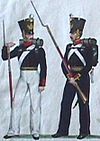
The Swedish allotment system was a system used in Sweden for keeping a trained army at all times. The oldest variant of the system came into use in around 1640, and in 1682 an updated system was introduced. Both systems relied on estates and farms that provided housing, salary and some military equipment for a soldier or horseman. In exchange, all other men in households providing soldiers escaped conscription, and households providing a horseman gained a large tax reduction. The system provided a well-trained, fast-mobilized and relatively cheap army that had large success on the battlefields of Europe during the 17th century, but the system also took its toll on the population. The allotment system was not replaced until the early 1900s, when the Swedish Armed Forces started using a conscription system. (continued...)
Recently featured: 1996 U.S. campaign finance scandal – Hong Kong action cinema – Attalus I
April 29
The Mini is a small car that was produced by the British Motor Corporation (BMC) and its successors from 1959 to 2000. The most popular British-made car of all time, it has since been replaced by the New MINI which was launched in 2001. The original is considered an icon of the 1960s, and its space-saving front-wheel-drive layout influenced a generation of car-makers. In an internet poll for "Global Car of the Century" the Mini came second after the Model T Ford. This revolutionary and distinctive two-door car was designed for BMC by Sir Alec Issigonis (1906–88). It was manufactured at the Longbridge and Cowley plants in the United Kingdom, and later in Australia, Belgium, Chile, Italy, Portugal, South Africa, Spain, Uruguay and Venezuela. The Mini Mk I had three major updates: The Mk II, the Clubman, and the Mk III, within which were a series of variations including an estate car, a pickup truck, a van, and the Mini Moke – a jeep-like buggy. The Mini Cooper and Cooper "S" were sportier versions that were successful as rally cars – winning the Monte Carlo Rally three times. (continued...)
Recently featured: Swedish allotment system – 1996 U.S. campaign finance scandal – Hong Kong action cinema
April 30
Diane Keaton is an American film producer, director, and actor. Keaton began her career as a stage actor, and made her screen debut in 1970. Keaton's first major film role was as Kay Adams in The Godfather (1972), but the films that shaped her early career were those with director and co-star Woody Allen. Her films with Allen such as Sleeper (1973), Love and Death (1975), and her Academy Award-winning performance in Annie Hall established her as a comic actor. Keaton has claimed that she is "tailor-made for comedy". Keaton ceased collaborating with Allen in 1979, and took on new roles to avoid becoming typecast as her Annie Hall persona. She became an accomplished dramatic actor, starting with Looking for Mr. Goodbar (1977) and received Academy Award nominations for Reds (1981) and Marvin's Room (1996). Some of her popular recent films include Father of the Bride (1991), The First Wives Club (1996), and Something's Gotta Give (2003). Keaton's films have earned a cumulative gross of over $1.1 billion USD in North America. (continued...)
Recently featured: Mini – Swedish allotment system – 1996 U.S. campaign finance scandal

